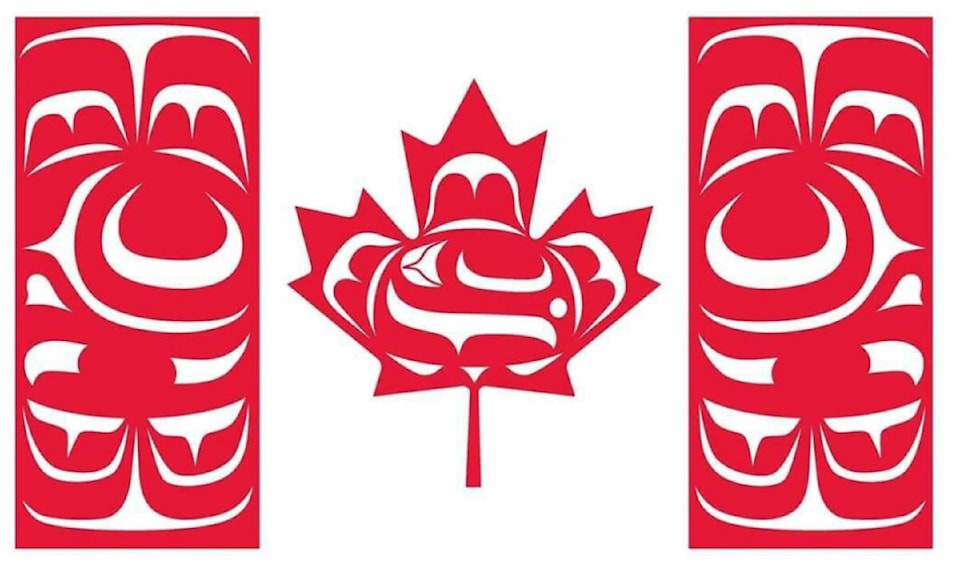Yme Woensdregt
This year, I spent some time on Canada Day reflecting on our history and heritage as Canadians. I thought about the need for healing in our relationship with Indigenous Peoples. But it also occurred to me that settler society needs healing.
This reflection was inspired by the flag designed by Curtis Wilson of the Kwakwaka’wakw First Nation near Campbell River (see inset). Wilson tells us on his website (www.canadianindigenousflag.ca) that he created this flag to inspire a sense of inclusiveness. His goal is to inspire us all to “Stand together in support of each other.”
Wilson’s design mimics the Canadian flag, with two red bands on either side of a white field containing a red maple leaf. The difference is that the red parts of the flag include Indigenous designs.
To quote Curtis Wilson, “The two designs on the red side bands are K’utala–Salmon. Salmon seemed the perfect way to convey the importance of family, friendships, and strength in numbers. There are as many types of people living here in Canada as there are types of salmon. I would like to see us coming together in the future, not only my First Nations people, but all of Canada.
“Salmon are known for dependability and renewal. Kwakwaka’wakw people think of them as a provider and a symbol of fertility and good health. The salmon is the source of life for our people, and we depend upon the salmon as our main food source in the past, present, and hopefully, the future.
“The design within the maple leaf is a head of a killer whale in the shape of an oval. The killer whale head is surrounded by some traditional use designs called split “U” shapes.”
I love this design. It acknowledges the troubled history of how Canada was built as a nation. European settlers came to this continent, arrogantly assuming that it was ours for the taking. We were bolstered by the Doctrine of Discovery, declared by Pope Alexander VI in 1493, which empowered Europeans to colonize any lands they “discovered.” In short, this Doctrine stated that any such lands populated by inhabitants who were not white or Christian could be treated as “terra nullius,” land which was empty. In other words, Indigenous People simply didn’t count as people.
Even though the Anglican Church and many other bodies have repudiated this Doctrine, the sad truth is that we settlers have much to confess and lament. We have done a lot of harm: Indian Residential Schools; the 60s scoop; the relocation of Indigenous Peoples to reserves which were usually the worst and least productive land around. We took away their heritage, their language, their culture, their spirituality, their land, their very identity.
At the same time, this Indigenous Flag is a sign of hope for me. I take Wilson’s words about “standing together in support of each other” to heart. I love the symbolism of the many types of people who live here coming together for the good of all. Of all. All people. All creatures. All ways of being and thinking, working, playing, and worshipping.
Randy Woodley, an American Indigenous activist and earth–tender, talks about living together as “kin in the Family of Creator.” This wonderful phrase holds out the hope that we are people with a common identity in Creator. It could quite easily be a synonym for what Jesus called “the Kingdom of God.” We share a common humanity as we live together in this earth which comes to us as a gift.
We are on a journey of reconciliation and healing in our land. There are some small signs of hope in our relationship with Indigenous Peoples. Together, we are receiving the gifts of forgiveness and reconciliation. The work of healing is coming alive among us. We only need to be open to receiving that gift so that we can work and live and play and laugh together as we move into a more peaceful and just future.
We see such a small and significant sign of hope in the transformation of the St. Eugene Mission in Cranbrook. It was built as part of the system of Indian Residential Schools in Canada which was designed to “beat the Indian out of the child” in order to assimilate Indigenous People. Local Ktunaxa leaders seized an opportunity to begin to rebuild the Ktunaxa nation. With courage and vision, they decided that the St. Eugene Residential School would become a place where they could assert their identity, re–learn their language, and renew their culture in the traditional land on which they have lived and for which they have cared for over 10,000 years. The community is taking steps towards self–sufficiency and self–determination.
There are other small signs, tiny seeds of hope being planted in fertile soil, which are beginning to bear fruit. We can nurture those seeds and feed the hope which is beginning to blossom.
There is still much work to be done. Canada is a work in progress. We require great healing.
That seems particularly true these days. Our life together is marked by deep cracks and crevasses. We have forgotten how to disagree with one another without being disagreeable. We find it increasingly difficult to speak to one another across the great divide. Our common identity as Canadians is being eroded.
Novelist Hugh McLennan described Canadian society as “two solitudes,” referring to the inability and unwillingness to communicate between Anglophone and Francophone people in Canada. Sadly, it seems as if our two solitudes have splintered into more solitudes than we can count, fostered by some hyper partisan politicians. One wonders if we can ever find our way back to a vision of unity among us.
Canada Day is a good day to reflect on what we can do as individuals and as a society and nation that strives to live together as kin of the Family of Creator.
Yme Woensdregt is a retired Anglican priest living in Cranbrook
